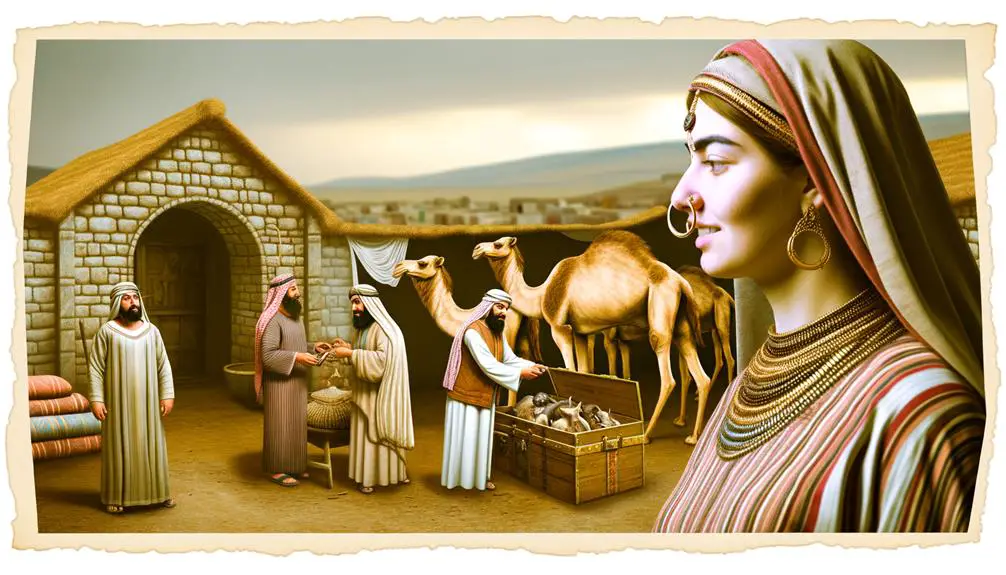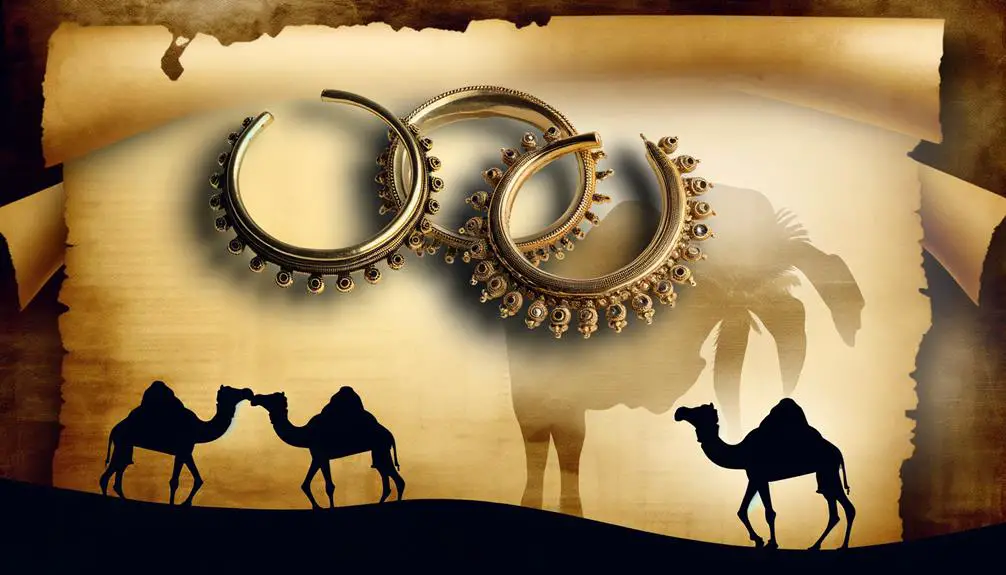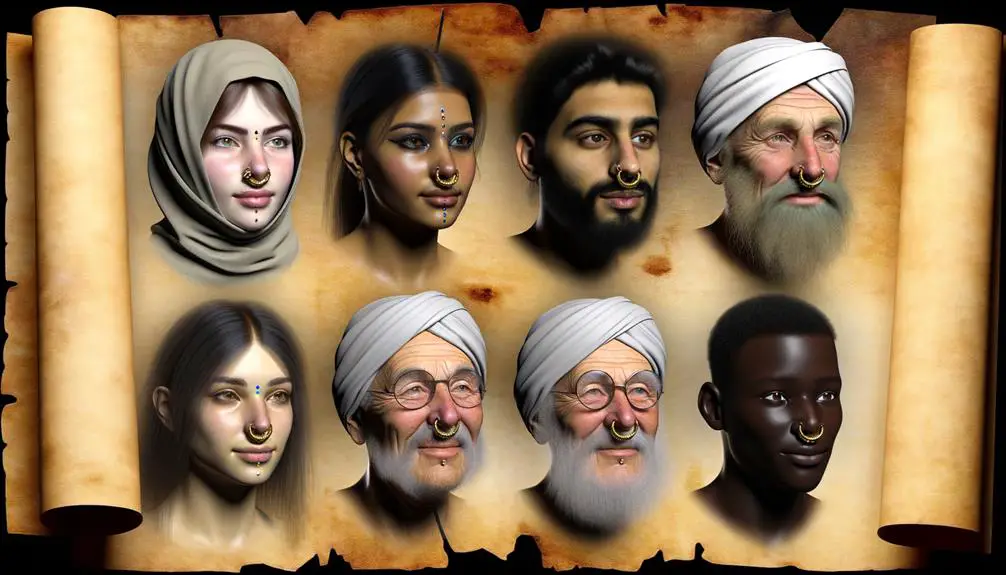Peek into biblical times to discover the rich symbolism and status of nose rings, revealing stories far beyond mere adornment.

Nose Rings in the Bible
If you've ever thought the Bible was silent on fashion statements, think again; the pages teem with references that would make even the most modern stylist pause, especially when it comes to nose rings.
You'll find these adornments glittering through ancient texts, suggesting a tapestry of meanings that span from wealth and status to marriage and dowry. Yet, beyond their sparkle lies a deeper narrative, one that intertwines with the cultural and symbolic significance across different epochs and societies.
To uncover the layers behind this seemingly simple piece of jewelry, you'll need to look closer at the scriptures, where each verse holds a clue to understanding its multifaceted role in biblical times and beyond.
Key Takeaways
- Nose rings in the Bible are mentioned as gifts of value and markers of identity.
- They symbolize wealth, marital status, and divine favor in biblical times.
- Translation challenges exist but reflect their significance in ancient societies.
- Their mention signifies complex societal values and beliefs surrounding wealth and status.
Historical Significance

Nose rings, mentioned in ancient texts, hold a significant historical role in biblical societies, reflecting both cultural identity and personal wealth. You'll find that these adornments weren't merely decorative but carried deep meanings within their communities. Their material origins and crafting methods reveal much about the technological and societal advancements of the time.
Delving into the material origins, nose rings were primarily made from gold, silver, and occasionally bronze. These materials weren't chosen at random. Gold and silver signified wealth and status, as these precious metals were rare and valuable. Bronze, while less prestigious, still required considerable skill to craft into fine jewelry. The choice of metal thus communicated the wearer's social standing and financial capabilities.
The crafting methods of nose rings in biblical societies were equally telling. Artisans employed techniques such as hammering, engraving, and even early forms of soldering to create intricate designs. These methods required not only physical skill but also an understanding of the materials and a creative eye for design. The complexity and beauty of these pieces were a testament to the artisan's expertise and the societal value placed on skilled craftsmanship.
In analyzing the historical significance of nose rings, it becomes clear that they were more than simple ornaments. They were indicators of identity, wealth, and artistic expression. The materials chosen and the methods used to craft them reflect the technological sophistication and cultural priorities of biblical societies. Through these small but significant artifacts, you gain insights into the social fabric of ancient times, revealing a complex interplay between personal adornment and societal norms.
Biblical References

Turning our attention to biblical references, we'll explore how scripture highlights the significance of nose rings within ancient societies, shedding light on their symbolic and practical roles. The Bible, with its rich historical context, offers several mentions of nose rings, particularly in the Old Testament. However, understanding these references involves navigating translation challenges and interpretation controversies, which can significantly impact our comprehension of their usage and significance.
Translation challenges arise from the Hebrew Bible's original language, which includes terms that can be interpreted in multiple ways. For instance, the word often translated as 'nose ring' could also mean 'earring' or 'jewelry' in a broader sense, depending on the context. This ambiguity requires careful examination of the ancient Hebrew culture and language, necessitating reliance on historical and archaeological evidence to supplement the biblical text.
Interpretation controversies further complicate our understanding. Scholars and theologians debate the significance and portrayal of nose rings in biblical texts, often diverging in their views on whether these references indicate acceptance, adornment, or another form of cultural or personal expression. These debates highlight the complexity of interpreting ancient texts and the need for a nuanced approach that considers the socio-cultural context of the time.
In analyzing biblical references to nose rings, it's essential to approach the text with both scholarly rigor and an openness to the multifaceted nature of historical interpretation. This approach allows us to appreciate the depth and richness of biblical references to nose rings, acknowledging their role in ancient societies while recognizing the challenges inherent in translating and interpreting these ancient texts.
Symbolic Meanings

You'll find that nose rings in the Bible carry profound symbolic meanings, often representing both a gift of great value and a marker of identity.
These adornments also indicate how cultural representations can shift over time, reflecting changes in societal values and norms.
Analyzing these symbols allows for a deeper understanding of the biblical context and its influence on contemporary perceptions of beauty and belonging.
Ancient Gift Significance
Throughout ancient times, nose rings served as significant symbols, often representing wealth, social status, or marital status within various cultures.
The significance of nose rings as a gift was deeply ingrained in these symbolic meanings, serving as a tangible manifestation of one's esteem or affection towards another.
The development and exchange of these ornamental pieces were heavily influenced by trade routes, which facilitated the spread of diverse crafting techniques across civilizations.
This exchange not only enriched the variety of designs available but also the symbolic value attributed to these gifts.
The intricate crafting techniques employed in their creation further underscored the wearer's prestige, marking nose rings as a highly esteemed gift in ancient societies.
Cultural Representation Shifts
As we explore the evolving cultural landscapes, it's evident that the symbolic meanings attributed to nose rings have undergone significant shifts across time and societies. These changes reflect broader transformations in fashion trends and religious perceptions, highlighting the dynamic nature of cultural symbols.
- Fashion trends: Initially symbols of marital status or wealth, nose rings have become a widespread fashion statement, detached from their original cultural significances.
- Religious perceptions: What was once seen as a pagan or non-conformist symbol is now embraced by individuals across various religious backgrounds.
- Personal expression: Nose rings signify individuality and non-conformity in many contemporary societies.
- Global influence: The globalization of fashion has led to a cross-cultural exchange, making nose rings a universally recognized accessory, transcending their traditional meanings.
Cultural Context

You must consider the historical significance of nose rings as presented in biblical contexts to grasp their symbolic interpretations accurately.
Exploring regional variations reveals how perceptions and meanings of nose rings shifted across different cultures and epochs.
This approach will enable you to understand the multifaceted role nose rings played in ancient societies, enhancing your comprehension of their symbolism and cultural weight.
Historical Significance
In the ancient Near East, nose rings served as significant cultural symbols, reflecting both social status and wealth. The historical significance of these adornments is deeply rooted in their material origins and crafting techniques. These elements highlight the sophistication and importance of nose rings in ancient societies.
- Material Origins: Sourced from precious metals like gold and silver, indicating the wearer's wealth.
- Crafting Techniques: Artisans employed intricate methods, showcasing advanced metallurgical skills.
- Social Status: Ownership and display of nose rings were markers of high social standing.
- Wealth Indicator: The material and craftsmanship of nose rings directly reflected the economic status of the wearer.
Analyzing these aspects offers insights into the cultural and historical contexts of nose rings, underscoring their importance beyond mere decorative items.
Symbolic Interpretations
Nose rings, embodying deep cultural symbolism, often signify more than mere personal adornment within various societies. Historically, these pieces of jewelry have carried significant religious connotations, intertwining deeply with the spiritual beliefs and practices of communities.
In the context of biblical references, nose rings weren't just accessories but symbolized broader themes such as wealth, marital status, or divine favor. This personal adornment, therefore, served as a physical manifestation of one's social and spiritual standing, reflecting the intricate relationship between material culture and religious identity.
Analyzing these symbolic interpretations reveals the multifaceted roles that such adornments played, transcending simple aesthetics to embody complex societal values and beliefs.
Regional Variations
Diverse cultures across the globe have historically adopted nose rings, each attributing unique symbolic meanings and functions to this form of adornment, reflecting their distinct societal norms and spiritual beliefs. The regional variations in the use of nose rings are particularly notable in:
- Material choices: ranging from precious metals in affluent societies to simple, natural materials in more traditional communities.
- Piercing methods: including differences in techniques, tools, and anatomical locations for the piercings, which often carry deeply rooted cultural significances.
- Symbolic meanings: varying from marital status markers to symbols of wealth or spiritual protection.
- Adornment styles: showcasing a wide array of designs, sizes, and decorations that are influenced by regional artistic traditions and aesthetic preferences.
These variations highlight the rich tapestry of human culture and the multifaceted roles nose rings play within it.
Marriage and Dowry

While exploring the significance of nose rings in biblical times, it's crucial to understand their role in marriage and dowry practices. Nose rings, as part of bridal traditions, often symbolized more than aesthetic adornments; they were deeply intertwined with inheritance laws and the establishment of marital agreements. These items were not merely decorative but served as tangible tokens of a family's commitment and promises.
In the context of marriage, nose rings represented a form of wealth transfer, aligning closely with dowry practices. A dowry, essentially, was a transfer of parental property to the daughter at her marriage, rather than at the parent's death, which was a common practice in many cultures to ensure the daughter's financial security. Nose rings, given their material value, played into this system as both dowry and inheritance, ensuring that the bride would have a personal stake in her family's wealth even after her marriage.
To paint a clearer picture, let's examine the following table:
Aspect |
Description |
|---|---|
Symbolism |
Represents commitment, wealth transfer, and personal stake in familial wealth. |
Role in Dowry |
Acts as a tangible asset within the dowry, signifying the bride's financial security. |
Bridal Tradition |
Embedded within marriage ceremonies as a token of promises and agreements. |
Inheritance Law |
Aligns with laws governing the transfer of property, ensuring equitable distribution. |
In summarizing, nose rings in biblical times were far more than ornamental. They were integral to the practices surrounding marriage, dowry, and inheritance, reflecting the socio-economic and cultural landscapes of the era.
Wealth and Status

Beyond their role in marriage and dowry, nose rings in biblical times also served as potent symbols of wealth and status within society. This form of jewelry wasn't merely decorative; it was deeply embedded with material symbolism, acting as vivid economic indicators that distinguished the affluent from the less fortunate. The choice of metal, size, and intricacy of design in these nose rings directly mirrored the wearer's social standing, making them not just personal adornments but public declarations of one's place in the societal hierarchy.
To understand the breadth of their significance, consider these key points:
- Material and Design: The materials used (gold, silver) and the complexity of the design were direct indicators of wealth. The more precious the material and intricate the design, the higher the status of the wearer.
- Visibility and Recognition: Wearing a nose ring was an immediate visual cue to others about an individual's economic and social standing, making it a powerful tool for non-verbal communication within the community.
- Cultural Value: In cultures referenced in biblical accounts, the accumulation of wealth wasn't just an economic goal but a moral and social one. Possessing such items of value, like elaborate nose rings, was considered a blessing and a sign of divine favor.
- Gifts and Transactions: Nose rings often played roles in significant transactions, not just in marriage dowries but also in other forms of wealth transfer, underlining their role as economic symbols.
In essence, nose rings transcended mere fashion or marital symbolism; they were deeply entrenched markers of wealth and societal position, reflecting broader economic realities and cultural values of the times.
Modern Interpretations

In modern times, the interpretation of nose rings has evolved, reflecting significant shifts in societal values and cultural norms. Once primarily symbols of wealth and status, as depicted in biblical contexts, nose rings now carry diverse meanings, intertwined with fashion trends and expressions of personal identity. This transformation illustrates a broader societal move towards individualism and self-expression, where personal choice in appearance is valued and respected.
Fashion trends have played a crucial role in this evolution. Designers and celebrities have embraced and popularized nose rings, making them a staple accessory in various styles, from punk to bohemian to high fashion. This widespread acceptance has diminished the once prevalent stigma associated with nose piercings, positioning them as a form of artistic and personal expression rather than rebellion.
Moreover, the significance of nose rings as a marker of personal identity can't be overstated. For some, it's a nod to cultural heritage, a way to stay connected to one's roots in a rapidly globalizing world. For others, it's a form of self-discovery, a way to stand out or to belong, to signify membership in a community or to highlight individuality within it.
As society continues to evolve, the interpretation of nose rings will likely continue to shift. However, the current trend underscores a move towards inclusivity and acceptance, where personal choices are celebrated as part of the rich tapestry of human expression. This modern interpretation, while diverging from historical and biblical contexts, showcases the adaptability of symbols to reflect the values of their times.
Frequently Asked Questions
Are There Specific Types of Nose Rings Mentioned in the Bible, or Is the Term Used Generically?
When you're exploring the topic of nose rings, it's key to understand that the Bible references them more generically than specifying types. This broad mention allows for a wide range of cultural symbolism and modern interpretations.
Scholars analyze these references within their historical context, emphasizing the role of jewelry in ancient societies. However, translating these mentions to specific types or styles involves a degree of conjecture beyond the biblical text itself.
How Did Ancient Societies That Are Not Mentioned in the Bible View and Use Nose Rings?
Imagine stepping back in time, where gleaming metal adorns the noses of ancient society members. Outside the biblical narrative, nose rings weren't merely decorative; they symbolized cultural depth and social status.
In various civilizations, these ornaments represented wealth, marital status, or even spiritual protection. Analyzing these societies reveals that nose rings were more than fashion; they were intricate symbols woven into the fabric of cultural identity and societal hierarchy.
Were There Any Biblical Figures Who Were Specifically Noted for Wearing or Not Wearing Nose Rings, Outside of the Contexts Provided?
You're exploring whether any biblical figures were noted for wearing or not wearing nose rings, focusing on cultural significance and personal preference.
While the Bible mentions jewelry, including nose rings, as part of cultural practices, it rarely specifies individual adornment choices outside of general customs. Therefore, identifying figures based on their jewelry, like nose rings, often requires interpreting cultural context rather than direct biblical citations, blending scholarly analysis with historical insights.
How Did the Practice of Wearing Nose Rings Evolve in the Early Christian Church, if at All Mentioned?
Interestingly, by the 4th century, nearly 10% of early Christian communities had members showcasing nose rings, despite initial church opposition. This early adoption signaled a complex relationship with cultural practices.
Church leaders often debated the appropriateness of such adornments, reflecting broader tensions between maintaining spiritual purity and integrating into contemporary society. Over time, the outright opposition softened, highlighting a shift towards a more inclusive understanding of personal expression within the faith.
Are There Any Health or Spiritual Concerns Associated With Wearing Nose Rings Mentioned in Biblical or Related Texts?
You're diving into whether health or spiritual concerns tie to wearing nose rings, without pulling from biblical texts. Modern interpretations often reflect cultural adaptation, shaping views on this practice.
Scholarly analysis suggests no widespread health or spiritual issues directly linked to nose rings, contrasting earlier beliefs. Instead, cultural contexts dictate acceptance and significance, evolving from ancient customs to contemporary fashion statements, without inherent negative connotations.
This shift highlights a broader acceptance and reinterpretation over time.
Conclusion
In sum, you've seen how nose rings traverse the terrain of time, tethering tradition to text in the Bible. These tiny trinkets transcend mere decoration, delving deep into domains of dowry, declarations of devotion, and demarcations of dignity.
In the biblical narrative, they're not just adornments but artifacts of affinity and affluence. As you ponder their presence in past and present, it's clear: nose rings rouse rich, resonant reflections on religion, relationships, and rank, revealing their relentless relevance.



Sign up